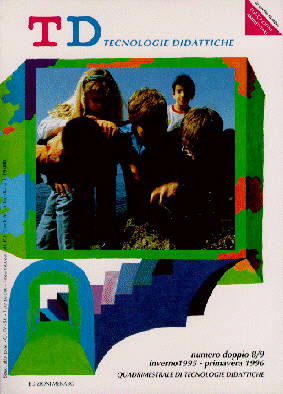Environment and education: a look at a scene change
Main Article Content
Abstract
Article Details
Authors who publish with this journal agree to the following terms:
- Authors retain copyright and grant the journal right of first publication with the work simultaneously licensed under a Creative Commons CC BY 4.0 Attribution 4.0 International License.
- Authors are able to enter into separate, additional contractual arrangements for the non-exclusive distribution of the journal's published version of the work (e.g., post it to an institutional repository or publish it in a book), with an acknowledgement of its initial publication in this journal.
- Authors are permitted and encouraged to post their work online (e.g., in institutional repositories or on their website) prior to and during the submission process, as it can lead to productive exchanges, as well as earlier and greater citation of published work (See The Effect of Open Access)
References
Berry R.J. (1993), Ethics, attitudes and environmental understanding for all, Field Studies: the Jourrnal of the Field Studies Council, 8, pp. 245-255.
Blakemore C. (1990), Who cares about science?, Science and Public Affairs, 4, pp. 97-119.
Botkin J.W., Elmandjro M. & Malitza M. (1979) No Limits to Learning: a report to the Club of Rome, Oxford, Pergamon Press.
Breiting S. (1993), The new generation of environmental education: focus on democracy as part of an alternative paradigm, in: Mrazek R. (Ed.) Alternative Paradigms in Environmental Education Research, pp. 199-202 Troy, OH, NAAEE.
Brennan A. (1994), Environmental literacy and educational ideal, Environmental Values, 3, pp. ~16.
Caduto M.J. (1985) A Guide on Environmental Values Education, Environmental Education Series 13 Paris, UNESCO.
Dansereau P. (1975), Inscape and Landscape: the human perception of environment, New York, Columbia University Press.
Davis S.B. (1993), Needed behavioural change: steps towards environmental security, in: Polunin N. & Burnett, J. (Eds) Surviving with the Biosphere, pp. 397416, Edinburgh, Edinburgh University Press.
Di Chiro G. (1987), Environmental education and the question of gender: a feminist critique, in: Robottom I. (Ed.) Environmental Education: practice and possibility, pp. 23-48 Victoria, Australia, Deakin University.
Fien J. (1993), Education for the Environment: critical curriculum theorising and environmental education, Geelong, Australia, Deakin University.
Grove-White R. (1994), Interlocutor’s statement, Workshop 2: society and culture, in: Values for a Sustainable Future, World Environment Day Symposium, London, 2 June.
Haber W. (1992), On transfer of scientific information into political action; experience from the German Federal Council of Environmental Advisors, INTECOL Bulletin, 1992:20, pp. 3-13.
Higgings R. (1975), The seventh enemy, The Observer Magazine, 23 February.
Holdgate M.W. (1994), Ecology, development and global policy, Journal of Applied Ecology, 31, pp. 201-211.
IUCN (World Conservation Union) (1970), International Working Meeting on Environmental Education and the School Curriculum, Nevada, Morges, Commission on Education, IUCN.
IUCN, UNEP & WWF (1980), World Conservation Strategy: living resources conservation for sustainable development, Gland, Switzerland, IUCN.
IUCN, UNEP & WWF (1991), Caring for the Earth: a strategy for sustainable living Gland, Switzerland, IUCN.
Jacobs J. (1975), Diversity, stability and maturity in ecosystems influenced by human activities, in: Van Dobben W.H. & Lowe-McConnell R.H. (Eds), Unifying Concepts in Ecology, pp. 187-207, The Hague, Dr W. Junk BV.
Lorenz K. (1974) Civilized Man’s Eight Deadly Sins, transl. M. Latzke, London, Methuen.
Lovelock J.E. (1979), Gaia: a new look at life on Earth, Oxford, Oxford University Press.
Mass Geesteranus C. (1994), Why haven’t we made environmental education redundant?, in: The Annual Review of Environmental Education 1993: on the fringe of the machine, pp. 2~27,Reading, Council for Environmental Education).
Patten B.C. (1982), Environs: relativistic elementary particles for ecology, The American Naturalist, 119, pp. 179-219.
Pezzey J. (1989), Definitions of Sustainability, London, UK CEED. Smyth J.C. & Stapp W.B. (1993), Learning to survive with the biosphere, in: Polunin N. & Burnett J. (Eds) Surviving with the Biosphere, pp. 244-252, Edinburgh, Edinburgh University Press.
Smyth J.C. (1977), The biological framework of environmental education, Journal of Biological Education, 11, pp. 103-108.
Smyth J.C. (1994), Prospects for a strategy for environmental education in Scotland, in: Royal Society of Edinburgh, Learning for Life: environmental education in Scotland, Proceedings of a Symposium, pp. 5-12, Edinburgh, 11 November.
SOEnD (Scottish Office Environment Department) (1993), Learningfor Life: a national strategy for environmental education in Scotland, Edinburgh, HMSO.
Spedding C.(1994), Biology and the citizen, Biologist, 41, p. 119.
Sterling S. (1992), Coming of Age: a short history of environmental education (to 1989), Walsall, National Association for Environmental Education.
Sterling S. (1993), Environmental education and sustainability: a view from holistic ethics, in: Fien J. (Ed.) Environmental Education: a pathway to sustainability, pp. 69-98, Geelong, Australia, Deakin University.
Tilbury D. (1994), The international development of environmental education: a basis for a teacher education model?, Environmental Education and Information, 13, pp. 1-20.
UNESCO (1977), The International Workshop on Environmental Education, Belgrade, October 1975, Final Report ED 76/WS/95, Paris, UNESCO.
UNESCO/UNEP (1978), Intergovernmental Conference on Environmental Education, Tbilisi (USSR), Final Report, Paris, UNESCO.
UNESCO/UNEP (1987) International Strategyfor Action in t/le Field of Environmental Education and Training for the 1990s (Paris, UNESCO).
United Nations Conference on Environment and Development (1992), Agenda 21, Geneva, UNCED.
Van Matre S. (1979), Sunship Earth: an acclimatization program for outdoor learning, Martinsville, IN, American Camping Association.
Vernadsky V.I. (1986), The Biosphere, an abridged version based on the French edition of 1929, Oracle, AZ, Synergetic Press.
Wheeler K. (1985), International environmental education: a historical perspective, Environmental Education and Information, 4, pp. 144-160.
Worcester R.(1994), The sustainable society: what we know about what people think and do, paper presented to Values for a Sustainable Future, World Environment Day Symposium, London, 2 June.
World Commission on Environment and Development (1987), Our Common Future, Oxford, Oxford University Press.

